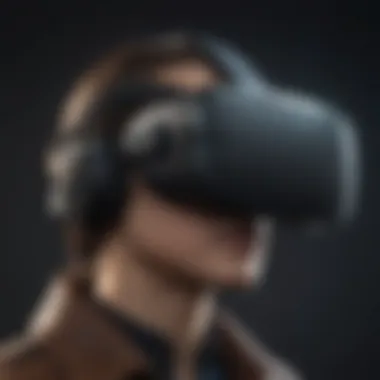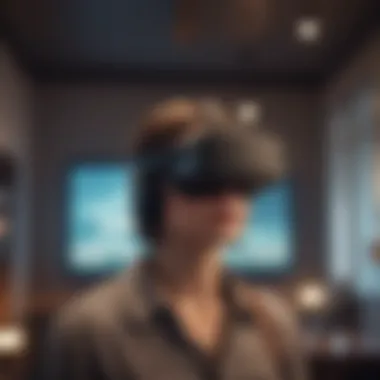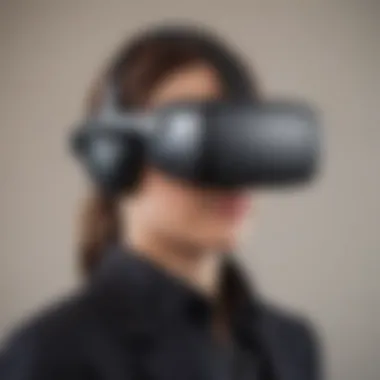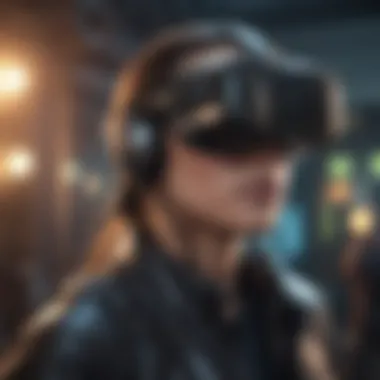Discovering Top iPhone Virtual Reality Headsets


Intro
In recent years, virtual reality has transformed how users engage with technology. The availability of compatible devices has opened new possibilities for immersive experiences. Among those devices, the iPhone stands out due to its widespread adoption and advanced features. This article aims to provide a comprehensive exploration of the best virtual reality headsets designed specifically for iPhone users. It will analyze various models, their compatibility, performance, and user experiences, all within the context of the evolving landscape of mobile virtual reality.
As interest in virtual reality continues to grow, understanding the available options and their technical specifications becomes essential. As such, this guide serves as a valuable resource for anyone looking to enhance their experience with Apple's technology, enabling more informed choices. By diving into this innovative field, readers will discover what defines the current market and what developments lie ahead.
Market Overview
Virtual reality is seeing significant shifts in consumer behavior and technology. The current market trends highlight a growing interest in mobile VR, fueled by advancements in smartphone technology.
Current Market Trends
Mobile virtual reality has gained traction as smartphones become more powerful. Features like high-resolution displays, improved processing power, and advanced sensors allow for more immersive experiences. Companies are now prioritizing user-friendly designs and enhancements in tracking and responsiveness in their products. Furthermore, the integration of augmented reality features into virtual reality headsets is emerging as a notable trend.
Economic Indicators Impacting the Market
Several economic factors influence the VR market's growth. Economic stability promotes consumer spending on technology, and increased competition among manufacturers fosters innovation. Additionally, global supply chain dynamics play a role in the availability and pricing of VR headsets. External factors such as trade agreements and tariffs may also impact market accessibility.
Global Influences and Major Events
The global landscape continually shapes virtual reality's direction. International tech conferences often unveil new technologies that push the limits of mobile VR. Major player events, such as Apple launches and other leading tech expos, provide critical insights into consumer expectations and industry advancements. Understanding these trends is vital for discerning what the future holds for iPhone-compatible virtual reality headsets.
The ongoing evolution of mobile technology is central to the popularity of virtual reality. With each iteration of the iPhone, possibilities expand.
Sector Analysis
To provide deeper insights into the virtual reality landscape, a closer look at significant market sectors can reveal growth patterns and emerging competitors.
Performance of Major Sectors
Various sectors are impacting the VR headset market, including gaming, education, and healthcare. The gaming sector leads in terms of user engagement, demonstrating high demand for immersive storytelling.
Comparative Analysis Between Sectors
The differences between sectors highlight unique consumer needs. For instance, educational tools require user-friendly interfaces and accessibility features, whereas gaming seeks high-performance graphics and responsiveness. This divergence influences how manufacturers design their products and target specific markets.
Emerging Sectors to Watch
As technology advances, sectors such as fitness and remote collaboration are gaining attention. The rise of fitness apps utilizing VR features meets a growing desire for immersive workout experiences. Similarly, remote collaboration tools are redefining communication, indicating a shift in how people connect digitally.
Finale
In summary, the virtual reality headset market for iPhone users reflects a dynamic interplay between technology, consumer preferences, and market demands. Understanding these aspects equips individuals with the knowledge to navigate this evolving space. As we move forward, continuous innovation and adaptation will shape how virtual reality continues to engage and transform user experiences.
Prelude to Virtual Reality on iPhone
Virtual Reality (VR) has transformed the landscape of digital interactions, particularly in how we engage with content on devices like the iPhone. The rise of VR technology has created unique opportunities for users to experience immersive environments and simulations directly through their smartphones. This section introduces the key elements of VR that make it pertinent for iPhone users, providing insight into both the benefits and considerations inherent to this technology.


Understanding Virtual Reality
Virtual reality is a computer-generated simulation that allows users to interact with a three-dimensional environment. This is done through specialized hardware, most commonly a VR headset. Key components in VR include audio and visual outputs that create an immersive experience. In the context of the iPhone, VR is increasingly important, as it leverages the phone's capabilities to deliver rich, engaging content. Users can enjoy games, educational programs, and virtual tours that transcend the limitations of traditional media.
The evolution of mobile technology has made advancements in VR accessible. Previously, VR required expensive setups with high-end computers. Now, devices such as Occulus Quest and lightweight VR headsets designed for smartphones provide an affordable entry point. The integration of VR in mobile platforms signifies a shift in how experiences are consumed.
Importance of Compatibility with iPhone
Understanding the significance of compatibility is essential for users looking to delve into the world of VR with their iPhones. Not all VR headsets support the iPhone model. Users must ensure that the headset they choose is compatible with their specific iPhone version.
An important consideration is that compatibility affects performance, graphical display, and user experience. For instance, some headsets require specific apps available only on certain iPhone models. The versatility of iPhone headsets also comes into play. Users should check if a VR headset is adaptable to various apps or if it’s tailored for specific functionalities, such as gaming or educational content.
“The right VR headset can enhance the immersive experience, allowing iPhone users to embrace the future of technology.”
Key Features of iPhone VR Headsets
Understanding the key features of iPhone VR headsets is crucial for users who want to maximize their virtual reality experiences. Given the increasing popularity of VR technology, selecting a headset that complements the iPhone is essential. The right choice can significantly affect the enjoyment and usability of virtual content.
Display Quality
Display quality plays a vital role in immersive experiences. High-definition screens are preferred as they offer clearer and sharper visuals. A resolution of at least 1080p is often a baseline expectation among users. When using VR headsets with an iPhone, the alignment of pixel density and screen type becomes important. The best headsets often utilize OLED screens, providing deeper blacks and higher contrast ratios.
Furthermore, the refresh rate is another key consideration. A higher refresh rate reduces motion blur and improves overall visual fluidity, resulting in a more comfortable viewing experience. This is especially relevant for fast-paced VR applications or games. Any lagging in visuals can lead to discomfort and motion sickness, which further emphasizes the importance of selecting a high-quality headset.
Field of View
Field of view (FOV) is another critical feature to assess when looking at iPhone-compatible VR headsets. FOV generally describes the extent of the observable environment that can be seen through the headset. A wider FOV enhances immersion, allowing users to feel a broader sense of space. This is particularly applicable in gaming and interactive experiences, where environmental cues play a significant role in engagement.
Typically, a FOV of at least 100 degrees is desirable for a more enveloping experience. However, this can vary among models, and users should ensure compatibility with the specific apps or games they intend to use. A headset with a narrow FOV may feel limiting and can diminish the overall virtual reality experience.
Comfort and Build Quality
Comfort and build quality are essential for prolonged use of VR headsets. An ideal headset should strike a balance between lightweight construction and sturdy materials to enhance user experience. Adjustable straps and cushioned interiors can greatly contribute to comfort levels and are common features in high-end models.
The material used in the making also matters. Breathable fabrics can help mitigate discomfort from extended wear, which is a common concern during longer sessions of use. Furthermore, headsets that allow for adjustments not only accommodate different user head sizes but also enable the user to find the best fit for enhanced stability.
Ultimately, the quality of the materials and the ergonomics of the design directly impact the user experience. Investing in a comfortable and well-constructed headset is important for both enjoyment and health.
High-quality display, a broad field of view, and comfort in design are all indispensable attributes for any meaningful VR experience on an iPhone.
Popular iPhone VR Headsets
The topic of popular iPhone VR headsets holds significant relevance within the realm of virtual reality. Understanding which headsets are compatible with iPhones helps users make informed choices and enhance their immersive experiences. Several aspects contribute to the importance of this discussion.
First, the array of options available can be confusing. Reviewing specific models allows consumers to weigh their choices based on features, compatibility, and user experiences. Second, identifying popular headsets can lead to a more fulfilling and seamless usage experience, ensuring users get the most out of their investment. Lastly, knowing prevalent models keeps consumers updated on the latest technology and advancements in mobile VR, which directly affects entertainment and productivity.
Oculus Quest Compatibility


The Oculus Quest 2 has gained significant attention as a standalone VR headset that also offers compatibility with the iPhone. Users can connect their iPhone to the headset using streaming software. It allows for a wider range of experiences, ensuring smooth integration of various VR applications.
One major benefit of this compatibility is the library access it provides. Oculus has an extensive catalog of games and experiences that users can explore. The connection also enables users to track their activities through smartphone apps, making it easier to manage their virtual adventures.
VR Headset by Merge
The Merge VR headset represents an accessible and affordable option for iPhone users. Designed with comfort in mind, it has a soft foam exterior that accommodates extended use. The headset’s build quality is notable, as it allows for easy adjustments and fits most iPhone models available today.
The Merge headset is also unique due to its educational applications. It can engage users in interactive learning experiences that other headsets do not emphasize. This feature positions Merge as a functional tool in both educational settings and casual use.
iVRy and its Unique Features
The iVRy headset distinguishes itself by offering compatibility with multiple devices, including iPhones. One unique selling point is its ability to function with games and applications that require more advanced specifications. This makes it highly versatile for users who demand performance efficiency.
Additionally, iVRy provides a user-friendly app that allows for easy setup and management. The headset supports various tracking systems, giving users flexibility based on their preferences. This adaptability makes it a compelling choice for serious VR enthusiasts looking to maximize their experience with their iPhone.
In summary, the landscape of iPhone VR headsets continues to evolve, with each model offering unique features and benefits that appeal to a diverse user base.
Performance Evaluation Criteria
Evaluating the performance of iPhone virtual reality headsets is crucial for users who seek an immersive experience. This section covers key areas that influence how effectively a headset operates with an iPhone. Proper assessment ensures that users make informed decisions regarding their VR headsets. The following elements are essential:
- Frame Rate: This indicates how many frames are rendered per second. A higher frame rate leads to smoother visuals, reducing motion blur and enhancing realism.
- Latency and Responsiveness: These factors are vital in determining how quickly the headset reacts to user input, which directly affects the overall experience.
Understanding these performance evaluation criteria not only helps in selecting the right headset but also ensures satisfaction in the user experience. Now, let's delve deeper into each criterion.
Frame Rate
The frame rate is a defining factor for virtual reality immersion. A headset with a high frame rate provides fluid motion and reduces the likelihood of motion sickness. For iPhone users, it means an engaging VR experience with instant feedback as they move within virtual environments. Typical frame rates for competitive headsets are around 90 to 120 frames per second.
If the rate drops significantly, users may experience lag, which can be jarring and detract from the immersive quality. It is important to opt for headsets that maintain a consistent frame rate even during intense gameplay or complex scenarios. Additionally, some headsets offer adaptive frame rates, which adjust based on content demands, thus optimizing performance.
Latency and Responsiveness
Latency involves the delay between a user’s action and the system’s response. In virtual reality, low latency is vital to create a seamless interaction with the virtual world. High latency can disturb the immersion by introducing a disconnect between the user's movements and the feedback they see. This can also lead to discomfort or disorientation.
Responsiveness ties closely to latency. It measures how quickly a headset can interpret the input from the user and render the corresponding changes in the virtual environment. A good VR headset should minimize these delays to enhance user experience. Developers often aim for a latency of under 20 milliseconds for optimal performance. Users should prioritize headsets that excel in both latency and responsiveness to ensure a satisfying VR journey.
The performance in VR is not just about having great visuals; it’s about how these visuals connect with user actions.
Comparative Analysis of Leading Models
In the landscape of mobile virtual reality, a comparative analysis of leading models serves an essential role. The objective is to dissect and understand the various offerings available for iPhone users. Comparing these models enables potential buyers to make informed decisions based on their unique needs, preferences, and budget. Key factors to consider include price, performance, and user satisfaction. In this regard, such an analysis sheds light on the strengths and weaknesses of each device, offering a clear picture of how they stack up against one another.
Price vs.
Performance


When it comes to virtual reality headsets for iPhone, the relationship between price and performance is crucial. Different models target various consumer segments, which can create confusion. Generally, higher-priced headsets provide advanced features such as improved display quality and enhanced audio. However, some budget options may also deliver satisfactory performance, making them suitable for casual users.
Consider the Oculus Quest 2, which is often praised for its performance relative to its price. Users appreciate its ability to provide a high-quality experience without breaking the bank. Conversely, more premium options may not always justify their price tags. Accessories and additional features like hand tracking can elevate the cost significantly, yet may not offer substantial advantages in everyday usage.
Ultimately, a careful evaluation of price versus performance is necessary for anyone looking to invest in iPhone-compatible VR. It allows users to find devices that match their expectations and financial constraints.
User Reviews and Feedback
Examining user reviews and feedback is invaluable in the comparative analysis of VR headsets. User experience often highlights real-world issues that technical specifications alone cannot reveal. Many reviews focus on comfort, usability, and the quality of the overall experience. Feedback from users frequently emphasizes the importance of comfort during extended use. Models that are ergonomically designed generally receive more favorable reviews.
Additionally, user feedback can indicate how well a device integrates with the iPhone. For example, headsets that offer seamless connectivity and ease of setup usually receive positive remarks.
Moreover, negative reviews can bring to light potential drawbacks or limitations of a model. Users may point out issues with motion sickness or insufficient content availability.
A collective understanding of user reviews paints a broader picture, allowing potential buyers to align their preferences with realities of each headset.
In summary, both price vs. performance analysis and user reviews contribute significantly to choosing the best iPhone virtual reality headset. By deeply understanding these aspects, potential buyers can confidently select a model that best fits their needs and expectations.
Future of iPhone Compatible VR
The future of virtual reality for iPhone users is not just an extension of technology; it represents a significant evolution in how individuals interact with digital environments. As virtual reality gains momentum in the mobile sector, understanding its trajectory becomes essential for users and developers alike. This future landscape will be shaped by advancements in hardware, software, and overall user experience.
Technological Innovations
Technological innovations are the backbone of future developments in iPhone-compatible virtual reality. Companies are investing heavily in research and development to produce lighter, more comfortable headsets with enhanced functionality. Some key innovations to note include:
- Enhanced Display Technologies: Expect improvements in resolution and refresh rates, resulting in crisper images and smoother motion.
- Advanced Tracking Systems: Enhanced motion tracking capabilities will allow for more natural interactions within virtual environments. This includes features like inside-out tracking enabling users to move without external sensors.
- Improved Integration with iOS: Better software compatibility will ensure that VR applications run seamlessly on iPhone devices, enhancing usability.
These innovations promise to improve immersive experiences significantly, making virtual reality more accessible and enjoyable for users.
Market Trends and Predictions
Analyzing market trends and making predictions is crucial for stakeholders interested in the future of iPhone-compatible virtual reality. Key observation points include:
- Increasing Demand for Mobile VR: As mobile technology evolves, an increasing number of consumers show interest in mobile VR. High-quality immersive experiences that can be enjoyed in portable formats will likely drive widespread adoption.
- Diverse Applications Beyond Gaming: Future applications will move beyond gaming into areas such as education, therapy, and virtual tourism. This diversification can lead to greater market growth and innovative use-cases for VR.
- Ecosystem Expansion: New players entering the market can enhance competition and spur technological advancements. Apple may also introduce more proprietary tools and frameworks to support VR development for iPhones.
The potential for growth in the iPhone-compatible VR market is considerable. Companies must remain vigilant and responsive to technological advancements and consumer preferences.
Identifying and understanding these trends can prepare investors and enthusiasts for the shifting dynamics of the market. Being informed will help in making strategic decisions in an ever-evolving landscape.
Epilogue
In this article, we explored the nuances of virtual reality headsets designed specifically for iPhone users. This exploration is significant as the user base for iPhone devices is substantial, and understanding the options available can greatly enhance the immersive experience for many individuals. The understanding of each headset’s unique features allows users to make more informed decisions tailored to their personal needs.
Key Takeaways
- Compatibility is Crucial: Not all VR headsets work seamlessly with iPhones. Understanding compatibility issues ensures users can enjoy their devices without frustration.
- Different Features Matter: The display quality, field of view, and comfort are key factors that can drastically influence the user experience. Users must consider these elements based on their preferences.
- Performance Evaluation: Frame rate and latency play an essential role in immersion. Knowledge about these aspects can help users appreciate the technical distinctions among different models.
Final Thoughts on iPhone VR Headsets
The landscape of virtual reality, particularly for iPhone, is advancing at a rapid pace. As technology grows, so too will the capabilities of VR headsets. It is essential for users to stay informed about the newest models and their specifications. Doing so will ensure they can continue to enhance their virtual experiences.
This exploration serves not just as an overview but also as a guide. The right virtual reality headset can transform one’s interaction with digital content. Prospective users should give thoughtful consideration to their choices in VR technology to align with their personal interests and needs.



